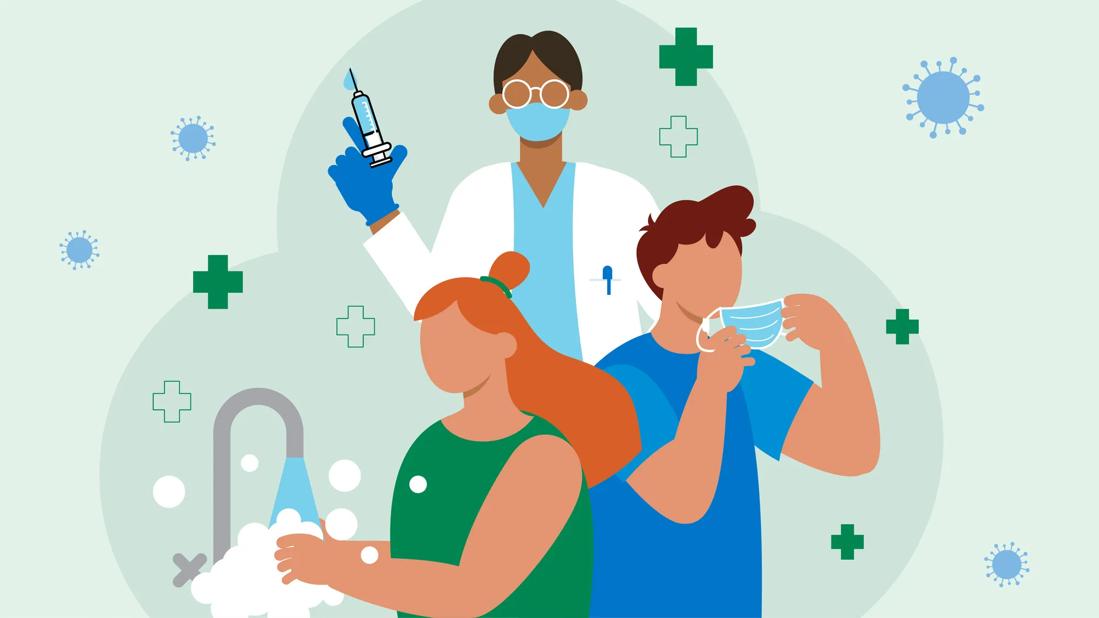Covering your mouth when you cough and staying home when you’re sick are a couple ways to help keep yourself and others COVID-free

Is COVID-19 still a pandemic all these years later? It depends on who you ask. Regardless, it’s important to prevent this nasty respiratory infection from spreading — and to protect yourself against complications.
Advertisement
Cleveland Clinic is a non-profit academic medical center. Advertising on our site helps support our mission. We do not endorse non-Cleveland Clinic products or services. Policy
Pulmonary and critical care physician Joseph Khabbaza, MD, shares advice for keeping yourself and your loved ones healthy.
Now that the lockdown days are long behind us, you can choose the precautions you take against COVID-19. The only question is, how much risk are you comfortable with? Here are some simple ways to stay COVID-free.
Staying up to date on COVID-19 vaccines and boosters is one of the best ways to reduce your chances of getting sick. If you do catch the virus, being vaccinated may help prevent complications and minimize the severity of the illness.
“Like the flu shot, COVID-19 vaccines are updated every year to reflect the variants of the virus that are circulating at the moment,” Dr. Khabbaza explains. “It’s like you’re reminding your immune system how to defend against the virus, while also preparing it to be exposed to new mutations.”
Just had COVID-19? The U.S. Centers for Disease Control and Prevention (CDC) recommends waiting 90 days before your next jab.
Reach out to your healthcare provider with any questions you have about vaccines. They can help you feel comfortable and confident with the decision you make.
“Wash your hands thoroughly with soap throughout the day, especially after returning home,” Dr. Khabbaza urges. “Lather your hands with soap for at least 20 seconds to get them fully clean. Hand hygiene sounds simple, but it’s extremely valuable for minimizing the spread of all viruses.”
Advertisement
Dr. Khabbaza also recommends keeping a small bottle of hand sanitizer with you when you’re out and about so you can keep clean when you don’t have immediate access to a bathroom.
“If you need to cough or sneeze, cover your mouth with a tissue or use your elbow to minimize the spread of respiratory droplets,” Dr. Khabbaza advises. “Then, throw out the tissue and wash your hands.”
Viral particles don’t build up as much in well-ventilated spaces, so turn on your air conditioning to keep air flowing. That reduces your odds of being exposed to COVID-19, along with other toxins in the air.
Don’t have AC? Open windows, run fans or invest in an air purifier instead.
If you don’t feel well or think you were exposed to the virus, Dr. Khabbaza recommends taking an at-home COVID test.
“If you test positive and you’re within the first five days of symptoms, you are a candidate for an antiviral treatment,” he explains. “That treatment will help reduce the severity of the illness.”
Fun fact: There’s now a two-for-one home test that also checks for the flu!
Consider masking if you:
You took every precaution, but you still got sick. Now what? Here’s what Dr. Khabazza recommends.
The days of quarantine and isolation guidelines are behind us. But the CDC still recommends staying home when you have COVID-19. You can return to your daily activities once you’ve met two conditions for 24 hours straight:
If you aren’t able to take time off and stay home, wear a mask and social distance to protect the people around you.
If you’ve got a mild case of COVID-19, you can often treat your symptoms at home with over-the-counter (OTC) medications, like:
If you have chronic conditions or take prescription medications, speak with your provider before starting an OTC treatment. They’ll check that your medication choices and dosages are safe.
If your symptoms are making you miserable — or you’re at high risk for complications — contact a provider and ask about COVID-19 therapies.
“Medications like Paxlovid®, Veklury® and Lagevrio™ have to be prescribed within five days of your symptoms starting. So, don’t wait too long to call your primary care office,” Dr. Khabbaza says.
Advertisement
If you’re severely ill, your provider may consider other prescription medications, like monoclonal antibodies.
COVID-19 isn’t a public health emergency anymore. But it’s still a serious upper respiratory infection. And it’s important to give your immune system the energy it needs to defend you against the virus. That means:
Depending on the type and severity of your symptoms, it may be OK to do some light exercise. Just don’t push yourself too hard.
It’s not unusual for a respiratory infection to overstay its welcome. But if you’re still feeling crummy after two or three weeks, visit your provider. You might be dealing with long COVID.
In that situation, Dr. Khabbaza says that you may need medication, pulmonary rehabilitation or physical therapy to make a full recovery.
Advertisement
Learn more about our editorial process.
Advertisement

Most can return to work or school when they’re symptom-free for 24 hours

This vital nutrient supports your health, but its role in COVID-19 prevention and treatment isn’t proven

Studies have shown promising results, but additional research is needed

Infection and inflammation can cause you to lose your voice and have other voice changes until you’re fully healed

A COVID-19 infection can bring on depression or anxiety months after physical symptoms go away

Just like the flu, COVID-19 continues to evolve every year with new and smarter variants

The latest omicron subvariants carry specific mutations that may allow the SARS-CoV-2 virus to be better at evading immune protection

You can work out with mild COVID-19, but not in a gym, and listen to your body and don’t overdo it

Start having sex about 72 hours before ovulation, then at least every other day during your fertile window

Attachment theory suggests that your earliest relationships shape connections throughout your life

It isn’t a recognized mental health disorder, but research shows that problematic social media use can negatively affect your mental health, self-esteem and sleep